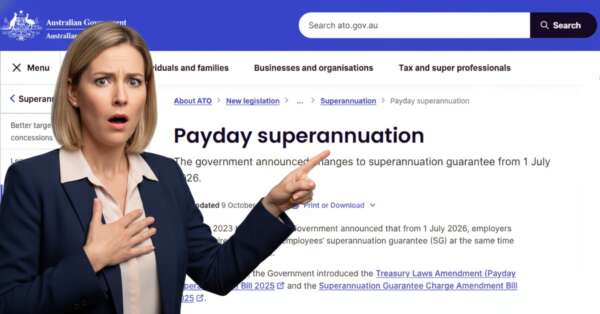Quick Summary
The superannuation guarantee rate increased from 11.5% to 12% on 1 July 2025 – the final scheduled increase in this series. All eligible employees must receive the 12% rate for salary and wages paid from 1 July onwards, even if the pay period started before this date. This represents the largest employer cost increase in years for most businesses.
Frequently Asked Questions:
Question: What is the new super guarantee rate for 2025?
Answer: The super guarantee rate increased to 12% from 1 July 2025. This applies to all eligible employees earning over $450 per month, calculated on ordinary time earnings up to the maximum contribution base of $250,000 annually. This is the final scheduled increase after gradual rises from 9% since 2013.
Question: Is it compulsory for my business to pay the 12% Super rate to all employees?
Answer:
Yes, paying the 12% superannuation guarantee rate is compulsory for all eligible employees from 1 July 2025. This is a legal requirement under the Superannuation Guarantee (Administration) Act, not an optional business decision.
Who must receive 12% super:
- All employees over 18 years old
- Employees under 18 who work more than 30 hours per week
- Full-time, part-time, and casual employees
- Temporary residents working in Australia
Who is exempt:
- Employees under 18 working 30 hours or less per week
- Some contractors (depending on their working arrangement)
- Employees earning less than $450 per month (though this threshold was removed in 2022).
Question: How much extra will the 12% super guarantee cost my business?
For a business with a $500,000 annual payroll, the super guarantee rate increase 2025 adds approximately $2,500 in extra superannuation costs per year (0.5% of total wages). A business paying $100,000 annually in wages will face an additional $500 per year, while larger employers with $1 million payrolls see an extra $5,000 annually.
Need help updating your payroll systems? Contact us here to get expert advice.
The real cost impact: what 12% means for your payroll
Right, let’s cut to the chase and talk real numbers.
The jump from 11.5% to 12% might sound modest, but when you’re running a business with multiple employees, that extra half percent adds up faster than you’d expect. I just calculated the annual impact for three different clients, and honestly, the numbers surprised even me.
Here’s what the super guarantee rate increase means for different business sizes:
| Business Size | Annual Payroll | Old SG Cost (11.5%) | New SG Cost (12%) | Extra Annual Cost |
|---|---|---|---|---|
| Small (5 employees) | $300,000 | $34,500 | $36,000 | $1,500 |
| Medium (10 employees) | $600,000 | $69,000 | $72,000 | $3,000 |
| Larger (20 employees) | $1,200,000 | $138,000 | $144,000 | $6,000 |
But here’s where it gets interesting – and where many business owners haven’t thought this through properly.
The timing of your pay cycles makes a huge difference to cash flow impact. If you pay weekly, you’re looking at an extra $29 per week for that small business, $58 for the medium one, and $115 for the larger operation. Doesn’t sound like much, does it? But if you pay monthly, that same small business suddenly needs to find an extra $125 each month, and the larger business needs $500.
I had a client last week – runs a small manufacturing operation with about twelve staff – who was genuinely shocked when I told him this change would cost him roughly $4,000 extra per year. He’d been so focused on other rising costs like insurance and materials that this one had completely slipped under his radar.
The real kicker comes down to how your employment contracts are structured. If you’ve got “plus super” arrangements where super is paid on top of the agreed salary, you wear the full cost increase. That’s most businesses, by the way. But if you’ve got “total package” deals where super comes out of the total amount, then technically the employee’s take-home pay drops to accommodate the higher super rate.
Guess which conversation is more awkward to have?
Want to calculate your exact cost increase? Let us help with the numbers and plan your cash flow properly.
Compliance essentials: getting the timing and calculations right
Look, I’ve seen too many businesses get tripped up on the technical requirements around the super guarantee rate increase, and the ATO doesn’t mess around with super compliance anymore.
The most critical thing to understand is the payment date rule. The 12% rate applies to all salary and wages paid from 1 July 2025 onwards, regardless of when the work was actually performed. This means if your pay period runs from 25 June to 8 July, but you pay on 10 July, the entire payment attracts the 12% rate.
This catches a lot of people out.
Here’s what you absolutely must get right:
Ordinary Time Earnings (OTE) calculation: The 12% applies to regular wages, salary, commissions, allowances that compensate for work duties, and some bonuses. It doesn’t include overtime penalty rates, expense reimbursements, or genuine allowances for expenses. If you’re unsure what counts as OTE for any of your payment types, don’t guess – the penalties for getting it wrong are severe.
Maximum contribution base: For 2025-26, the maximum you need to pay super on is $250,000 per year, per employee. That’s about $4,808 per week if you’ve got high earners. Most businesses won’t hit this limit, but if you do, make sure your payroll system handles the cap correctly.
Quarterly due dates haven’t changed: You still need to pay super by the 28th of January, April, July, and October. The SuperStream requirements remain the same too – electronic payment and data transmission for employers with 20 or more employees, though most smaller employers use it anyway through their payroll software.
Here’s a mistake I’ve seen three times already since July: businesses calculating the increase as 0.5% on the total wage bill instead of increasing the super rate to 12%. Sounds obvious when I say it like that, but when you’re busy and the software isn’t updated properly, it’s an easy error to make.
The ATO’s Super Guarantee Charge (SGC) penalties are brutal if you get this wrong – 10% penalty on top of the shortfall amount, plus interest. For a business with $500,000 in wages, an incorrect calculation could easily cost $5,000+ in penalties and interest charges.
Unsure about your compliance obligations? Book a review with our team before the ATO comes knocking.
Payroll system updates: don’t get caught out
This is where most businesses either sail through the change effortlessly or create an absolute nightmare for themselves.
The good news first: if you’re using online pltforms such as Xero or MYOB, both platforms should have automatically updated to reflect the 12% rate from 1 July. Xero pushed their update in late June, and MYOB rolled theirs out around the same time. These systems are generally pretty reliable with statutory rate changes because they have to be – too many businesses rely on them so they can’t get it wrong.
But here’s my strong recommendation anyway: test your calculations manually for the first few pay runs.
I learned this lesson the hard way about five years ago when a software glitch in a client’s system underpaid super for two months before we caught it. The paperwork and potential penalties were a total pain, not to mention the stress of explaining to employees why their super statements were wrong.
Here’s what you should do right now:
Xero users: Check that your payroll templates show 12% superannuation rate. Go to Payroll > Employees > select an employee > Employment tab > Superannuation section. The rate should show 12.00%.
MYOB users: Navigate to Card File > Cards List > Employees > select employee > Payroll Details > Superannuation tab. Verify the rate shows 12%.
Manual payroll systems: If you’re still doing payroll manually (please consider upgrading – it’s 2025!), you’ll need to update your calculation spreadsheets or templates to use the 12% rate for all pays from 1 July onwards.
One client’s MYOB software wasn’t updated automatically because they were running an older version that required manual updates. We caught it just in time during their first July pay run, but it could have been a problem if we’d processed the entire month incorrectly.
For businesses using other payroll software like Employment Hero, BambooHR, or specialist industry systems, contact your software provider directly to confirm the update has been applied correctly. Don’t assume anything when it comes to statutory compliance.
Employee communication: Your staff will notice the higher super contributions on their payslips, especially those who closely monitor their super balance. A quick email explaining the increase shows you’re on top of things and prevents confusion.
Need help auditing your payroll setup? Contact us for a system check – better safe than sorry with ATO compliance.
Employee contract implications: who pays the extra cost?
This is where things can get legally and practically complicated, and I’ve seen some genuinely difficult conversations with employees over the past few months.
The impact of the super guarantee rate increase depends entirely on how your employment contracts are structured, and many business owners don’t fully understand which type they’re using.
“Plus super” contracts – this is where the employee receives their agreed salary plus superannuation on top. Most employment contracts work this way, especially for hourly workers and standard salary arrangements. Under these contracts, the employer wears the full cost of the increase. If you agreed to pay someone $60,000 plus super, you now pay $60,000 plus 12% super instead of 11.5% super. Simple, but expensive for the business.
“Total package” or “cost to company” contracts – these specify a total amount that includes superannuation. Less common but used for senior roles and some professional positions. Here, the employee’s take-home pay actually reduces to accommodate the higher super rate. If someone’s on a $70,000 total package, their base salary drops to ensure the total cost (including the higher super) remains $70,000.
I had to explain this to three clients last month whose employees were on total package deals. They weren’t thrilled to discover their take-home pay had dropped, even though their superannuation contributions increased. One of them asked if they could opt out of the increase – which, of course, they can’t because it’s legislated.
Award and enterprise agreement considerations: If your employees are covered by awards or enterprise agreements, check whether these specify “plus super” or total package arrangements. Some agreements have specific clauses about how superannuation increases are handled.
For businesses considering contract changes, be very careful. You can’t unilaterally change existing contracts from “plus super” to “total package” just to avoid the cost increase. That requires genuine agreement from employees and proper documentation.
The communication strategy matters enormously here. Employees on plus-super arrangements are generally happy about the increase – more super for retirement. Those on total packages need careful explanation about why their pay has effectively dropped, even though they’re not worse off long-term.
Need advice on contract reviews and employee communications? Contact us here to get expert guidance on handling these conversations properly.
Beyond 2025: what’s next for super guarantee
Here’s what every business owner should know: this super guarantee rate increase to 12% is the final scheduled increase in this series.
That’s right – barring any future government policy changes, 12% is where super guarantee stops. The gradual increases that started from 9% in 2013 are now complete. For business planning purposes, you can budget on 12% being the rate for the foreseeable future.
But don’t get too comfortable.
The big change coming in 2026 is “payday super” – the proposal to require superannuation payments with each pay cycle instead of quarterly. This won’t change the 12% rate, but it’ll significantly impact cash flow management for most businesses. Instead of paying three months of super contributions in one quarterly lump sum, you’d pay it weekly or fortnightly along with wages.
The government’s logic is sound – it’ll improve cash flow for employees and reduce the risk of businesses accumulating large super debts they can’t pay. But for employers, particularly those who use quarterly super payments as a cash flow management tool, it represents a significant change to financial planning.
Industry speculation suggests other changes might be coming too. There’s ongoing discussion about extending super guarantee to contractors, lowering the $450 monthly minimum threshold, and potentially adjusting rates for different age groups. Nothing’s confirmed, but these conversations happen regularly in policy circles.
For retirement adequacy purposes, 12% is considered the minimum needed to provide reasonable retirement outcomes for most workers. Some experts argue it should be higher, while business groups obviously prefer it stays where it is. The current government hasn’t indicated any intention to increase rates further, but that could change with different political priorities.
What this means for your business planning is that you should budget for 12% super costs ongoing, but stay flexible for potential changes to payment timing from 2026. The rate itself looks stable, but the administrative requirements might evolve.
Stay ahead of super changes with ongoing professional guidance – contact us here to ensure your business is prepared for whatever comes next.
This article provides general information only and shouldn’t be considered personal financial advice. The super guarantee rate increase in 2025 affects different businesses in different ways – always get professional advice for your specific situation.












